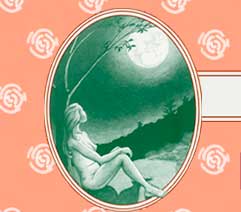Susun Weed. Green Nations Gathering 2000.
Nothing improves health faster and more firmly than regular use of nourishing herbal infusions and medicinal vinegars.
Includes information on stinging nettle, oatstraw, comfrey leaf, red clover, linden, and aromatic mints.
![]() Price: $22.50
Price: $22.50
EXCERPTS
Making Infused Oils
by Susun Weed
In your herbal pharmacy you transform fresh and dried plants into herbal medicines. Learning to identify and use the common plants around you is easy and exciting, beneficial and safe. Making your own medicines saves you money if you follow the Wise Woman tradition of using local herbs, free for the taking.
Even one day's work in field, forest, and kitchen can provide you with many years' worth of medicines. When you make your own, you know for sure what's in it, where it came from, when and how it was harvested, and how fresh and potent it is.
Dried herbs are best for the infusions recommended in this book. Stock your herbal pharmacy with your own foraged or cultivated dried herbs; expand your resources and experiment with new herbs by buying dried herbs from reputable sources.
Fresh herbs are best for the tinctures and oils recommended in this book. If you can't make your own, buy from sources who wildcraft or grow their own herbs to use fresh in preparations.
Whether you buy or make your own medicines, remember, herbal remedies may not work or may work incorrectly if they aren't prepared correctly. Read this chapter carefully; it contains easy to follow instructions for every remedy and preparation mentioned in this book [Wise Woman Herbal for the Childbearing Year].
Oil Bases
There are two very different types of oil-based herbal medicines. They are known as essential oils and infused oils.
Essential oils cannot be made easily at home. They are the pure plant oil, usually extracted by chemicals or hot steam. Hundreds of pounds of fresh plant material may produce only ounces of essential oil. Essential oils are readily available commercially. They are used in aroma therapy, as insect repellents, and to increase local circulation.
Essential oils are intended for external use. They can be fatally poisonous if taken internally in quantity. They are also highly irritating to the mucus surfaces of the body (genitals, mouth, eyes, etc.) and may cause allergic skin reactions in some people. Be certain to keep all essential oils well out of the reach of children.
Infused oils can be made at home. They are usually reserved for external uses, but could be taken internally without disastrous results. Infused oils are much less potent than essential oils and have none of the associated side effects. Infused oils can only be made from fresh plants, with the exception of some roots which can be coaxed into an oil base if baked in the oven for many hours.
Infuse herbs in any type of oil: olive, safflower, apricot, coconut, etc. The lighter, clearer oils are expensive; they produce delicate and beautiful infused oils. Olive oil is my personal choice; it rarely turns rancid, is absorbed easily into the skin, adds its own healing benefits to the preparation, and is available inexpensively.
Making Infused Oils
° Pick the plant on a dry, sunny day.
° Discard any diseased or soiled parts. Do not wash any part of the plant. If there is dirt on the plant, scrub it off with a stiff, dry brush.
° Chop the plant coarsely.
° Completely fill a clean, very dry jar with the chopped herb.
° Slowly pour oil into the jar, poking with a chopstick or knife to release air and make sure the oil penetrates into all layers of the herb.
° add enough oil to thoroughly cover all the plant material and fill the jar to the very rim. (As with preparing a tincture, it is really possible to fill that jar twice: once with herb and then again with the vehicle.)
° Cork the jar or screw on a lid.
° Label the jar with he name of the plant, the plant part used, the kind of oil used, and the date. Example: St. Joan's Wort, leaf and flower, olive oil, 21 June 1985.
° Keep the jar of infused oil at normal room temperature and on a surface that will not be ruined by seeping oil.
° Decant the infused oil in six weeks. The plants can be left in the oil longer, but have a tendency to mold and spoil if not kept very cool.
° Oil held in the plant material after the decanting can be extracted. Put small handfuls into a clean kitchen towel or cotton cloth; squeeze and wring out the oil.
° Allow the decanted oil to sit for several days while the water in it (from the fresh plant material) settles to the bottom of the jar. Then carefully siphon or pour off the oil, leaving the water behind.
° Store at cool room temperature or refrigerate.
Trouble Shooting Infused Oils
Mold grows readily in infused oils. the presence of any moisture on the herb or in the jar encourages mold growth.
° If the jar is not filled to the top, mold will grow in the air space left. To save your preparation, completely remove the mold and fill the jar to the top with fresh oil.
° If the jar was not totally dry when you filled it, mold will grow along the inside of the jar. Save your preparation by carefully pouring the oil and the plant material into a dry jar. Jars dried in the oven for five minutes immediately prior to use prevent this problem.
° If the jar is put in the sun or left near a heat source, the warmth will cause condensation inside the jar, providing the moisture necessary for colonies of mold. Remove the mold and pour oil and plant material into a fresh jar to save this.
° If the plant material was wet when combined with the oil, mold will grow throughout the oil. Saving it is impossible. Start again.
Some herbs release gas as they infuse. You may notice bubbles moving in the oil; this is not a problem and does not indicate spoilage. Chickweed, Comfrey, and Yellow Dock are notable in their gas production when infused in oil. The gas will force some of the oil out of the jar (yes, even if tightly capped). Corked jars go pop! Rancidity occurs when there is plenty of heat and oxygen.
Infused oils in an olive oil base resist rancidity at cool room temperature for several years. In very warm climates, adding the contents of a capsule or two of vitamin E to the decanted oil helps prevent rancidity. Tincture of Myrrh or Benzoin added to ointments also checks rancidity; use about ten drops of either per ounce of oil.
Making Ointments
Ointments and salves are easily made from infused oils.
° Pour one ounce of infused oil into a very small pan.
° Grate a tablespoon of beeswax and add it to the oil. (Buy beeswax from a local beekeeper, craft supply shop, or marine supply store.)
° Place the pan on low heat; a candle flame will suffice.
° Stir constantly until the beeswax is totally melted. This rarely takes more than a minute or two.
° Pour the liquid into your ointment jar and allow to cool and solidify.
° If the consistency is too hard, remelt and add more infused oil.
° If the consistency is too soft, remelt and add more beeswax.
Green Blessings.
Susun Weed



